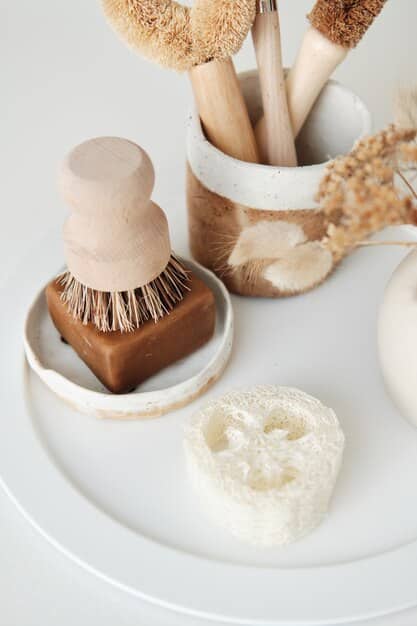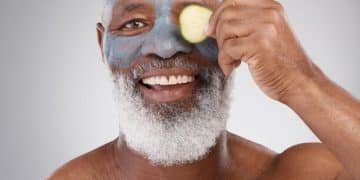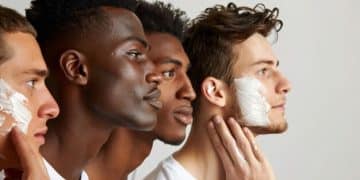Ingrown Hair Prevention: Updated Guide for Smooth Skin in 2025

Achieving smooth, irritation-free skin in 2025 means mastering ingrown hair prevention through advanced skincare routines, proper hair removal techniques, and consistent exfoliation to maintain optimal skin health and appearance.
For anyone seeking truly smooth, irritation-free skin, understanding and practicing effective ingrown hair prevention: The Updated Guide to Smooth, Irritation-Free Skin in 2025 is absolutely essential. These pesky bumps can mar even the most diligent skincare efforts, but with the right knowledge and routine, they are entirely preventable.
Understanding Ingrown Hairs: More Than Just a Nuisance
Ingrown hairs are a common skin condition where hair curls back or grows sideways into the skin, causing inflammation, redness, and often painful bumps. While frequently associated with shaving, they can occur after any hair removal method that cuts the hair at or below the skin’s surface, whether it’s waxing, epilating, or even plucking. The resulting irritation can range from mild annoyance to significant discomfort, sometimes leading to infection or hyperpigmentation.
Understanding why ingrown hairs form is the first step toward effective prevention. When hair is removed, particularly if it’s cut sharply or close to the skin, the new growth can struggle to emerge from the follicle. Instead of growing upwards, it may curl back into the skin or get trapped underneath dead skin cells. This triggers a foreign body reaction, leading to inflammation and the characteristic red, itchy, or painful bump. Factors like curly or coarse hair, certain hair removal techniques, and even skin type can increase susceptibility.
The Role of Hair Type and Skin Conditions
Certain hair types are inherently more prone to ingrown hairs. Individuals with naturally curly or coarse hair often find that their hair has a greater tendency to curl back into the skin, especially after being cut short. This intrinsic curvature makes it challenging for the new hair shaft to break through the skin barrier cleanly. The rigid structure of coarse hair can also make it more difficult for it to emerge without resistance, leading to potential entrapment.
Beyond hair texture, various skin conditions can exacerbate the problem of ingrown hairs. Dry skin, for instance, can lead to a buildup of dead skin cells that effectively create a barrier, trapping emerging hairs beneath the surface. Similarly, chronic inflammation or conditions like keratosis pilaris (KP) can alter the skin’s surface and follicular environment, making ingrown hairs more frequent and severe. Addressing underlying skin health is therefore a critical component of a comprehensive prevention strategy.
- • Curly Hair Predisposition: Natural curl makes hair more likely to re-enter the skin.
- • Coarse Hair Toughness: Strong, thick hairs can struggle to penetrate the skin surface.
- • Dry Skin Buildup: Dead skin cells block follicles, trapping new growth.
- • Inflammation Aggravation: Pre-existing skin irritation can worsen ingrown hair development.
Ultimately, while ingrown hairs can be frustrating, viewing them as a signal from your skin about its needs is helpful. They indicate that the hair removal method or your post-hair removal care might need adjustment. By understanding the root causes, we can tailor our approach to prevent their occurrence, rather than simply reacting to them. This involves not just technique changes but also a deeper commitment to overall skin health and maintenance.

Pre-Hair Removal Preparation: Setting the Stage for Success
Effective ingrown hair prevention truly begins before any hair is removed. The state of your skin and hair prior to shaving, waxing, or epilating plays a crucial role in how smoothly the hair removal process will go and how cleanly your hair will emerge afterwards. Proper preparation aims to soften the hair, open the follicles, and remove any surface barriers that might trap new growth. This foundational step is often overlooked but is indispensable for achieving and maintaining smooth, irritation-free skin.
The primary goal of pre-hair removal preparation is to create an optimal environment for hair removal. This involves ensuring the skin is clean, soft, and free from dead skin cell accumulation. Starting with a clean base is vital to prevent bacteria from entering freshly opened follicles during the hair removal process, which could lead to infection or further inflammation. Equally important is softening the hair, making it more pliable and easier to cut or pull, reducing the likelihood of breaking the hair unevenly or below the skin’s surface.
The Power of Exfoliation: Chemical vs. Physical
Exfoliation is arguably the most critical step in pre-hair removal preparation. It works by removing the outermost layer of dead skin cells, which can otherwise clog follicles and trap emerging hairs. There are two main types of exfoliation, each with distinct benefits: physical and chemical. Physical exfoliation involves using abrasive materials, like scrubs or exfoliating mitts, to manually slough off dead skin. Chemical exfoliation uses acids, such as AHAs (Alpha Hydroxy Acids) or BHAs (Beta Hydroxy Acids), to dissolve the bonds between dead skin cells, allowing them to shed naturally.
For effective ingrown hair prevention, chemical exfoliants are often preferred, especially those containing salicylic acid (a BHA). Salicylic acid is oil-soluble, meaning it can penetrate deeper into the pores to dissolve sebum and dead skin cells from within the follicle, directly addressing one of the root causes of ingrown hairs. Glycolic acid (an AHA) is also beneficial for surface exfoliation and improving skin texture. When choosing a physical exfoliant, opt for gentle options with fine particles to avoid micro-tears in the skin, which can lead to irritation and further exacerbate the problem.
- • Chemical Exfoliants: Utilize AHAs (Glycolic Acid) for surface renewal and BHAs (Salicylic Acid) for deep pore cleansing.
- • Physical Exfoliants: Opt for gentle scrubs or brushes, avoiding harsh, abrasive textures.
- • Frequency is Key: Exfoliate 2-3 times a week, but not immediately before or after hair removal to prevent over-irritation.
- • Warm Water Prep: A warm shower or bath opens pores and softens hair, making removal easier and less prone to nicks and trapped hairs.
Beyond exfoliation, a warm shower or bath before hair removal is highly recommended. The warm water helps to soften the hair and open up the follicles, making hair easier to remove with less resistance. This reduces the chances of hair breaking or being pulled in an unnatural direction, both of which can contribute to ingrown hair formation. Hydrating the skin from within is also crucial; well-hydrated skin is more pliable and resilient, less prone to irritation and better equipped to allow new hair growth to emerge cleanly. By investing time in these preparatory steps, you lay a solid foundation for smooth skin and significantly reduce your risk of ingrown hairs.
Optimizing Hair Removal Techniques: Shave Smarter, Not Harder
The way you remove hair is perhaps the most direct factor influencing the likelihood of developing ingrown hairs. While no method is entirely foolproof, optimizing your technique for each specific scenario can dramatically reduce the risk. This involves not just the immediate action of removing hair but also the tools you choose and the mindful approach you take to the process. Moving beyond quick, habitual routines to a more deliberate and informed practice can make all the difference in achieving long-term smooth skin.
For shaving, the most common hair removal method, the goal is to cut the hair cleanly at the skin’s surface without pulling it or cutting it too short under the skin. This requires attention to blade sharpness, shaving direction, and lubricant choice. For waxing or epilating, efficiency and proper technique are paramount to ensure the hair is removed completely from the root, minimizing breakage that can lead to ingrown issues. Each method presents its own set of challenges and best practices, all aimed at fostering healthy hair regrowth.
Shaving Best Practices: The Cornerstones of Prevention
When shaving, several key practices stand out as essential for ingrown hair prevention. Firstly, always use a sharp, clean razor. Dull blades drag and pull the hair, leading to uneven cuts and greater likelihood of hair breakage below the skin’s surface, which significantly increases the risk of ingrown hairs. Replace blades frequently, ideally after 5-7 uses, or sooner if you notice resistance. Secondly, shave with the grain of your hair growth, not against it. While shaving against the grain often provides a closer shave, it also pulls the hair upwards, cutting it at a sharper angle and increasing its tendency to curl back into the skin. Shaving with the grain minimizes this risk, providing a smoother, safer shave.
Thirdly, prepare your skin with a good quality, lubricating shaving cream or gel. This creates a protective barrier between the blade and your skin, allowing the razor to glide smoothly and reduce friction, nicks, and irritation. Let the cream sit on your skin for a minute or two to further soften the hair. Finally, avoid applying excessive pressure; allow the razor to do the work. A light touch is all that’s needed to remove hair effectively. Rinsing the blade frequently during your shave also helps maintain its efficacy and prevents clogging, ensuring a consistently clean cut.
- • Sharp Blades: Always use a fresh, sharp razor to ensure a clean cut.
- • Shave with the Grain: Go in the direction of hair growth to minimize pulling and blunt cuts.
- • Quality Lube: Use a rich shaving cream or gel, not just soap, for maximum glide.
- • Light Pressure: Let the blade do the work; pressing too hard causes irritation and hair breakage.
Waxing and Epilating: Techniques for Cleaner Removal
For those who prefer waxing or epilating, the principles of cleanliness and technique are equally vital. When waxing, ensure the skin is clean and dry. Apply wax in the direction of hair growth and remove it quickly and firmly against the grain, keeping the skin taut. This minimizes hair breakage and helps ensure the hair is pulled from the root. Improper waxing can often lead to hair breaking off at the skin level, setting the stage for future ingrown issues. The length of the hair also matters; hair that is too short might not be effectively gripped by the wax, leading to multiple passes or incomplete removal.
Epilators, which mechanically pluck hairs, require careful preparation and technique. Ensure your skin is clean and exfoliated to allow the epilator to grasp hairs effectively. Hold the epilator at a 90-degree angle to the skin and glide it slowly, often against the direction of hair growth, to ensure thorough removal. While epilating can be more painful initially, consistent use can lead to finer, sparser hair over time. Regardless of the method, immediately following hair removal with soothing, non-comedogenic products is crucial to calm the skin and support healthy pore function.
Post-Hair Removal Care: Soothing and Sustaining Smoothness
Hair removal isn’t just about the act itself; what happens immediately afterwards is just as crucial for preventing ingrown hairs and maintaining smooth, healthy skin. The skin, particularly if sensitive, can be left vulnerable, inflamed, or dry after hair removal. Proper post-care aims to soothe irritation, close pores, prevent bacterial entry, and support the skin’s natural healing and regenerative processes. Neglecting this phase can undo all the diligent preparation and careful hair removal techniques.
The goals of post-hair removal care are multi-faceted: reducing inflammation, preventing infection, and ensuring the skin remains hydrated and supple. Inflammation is a natural response to the trauma of hair removal, but prolonged or severe inflammation can obstruct follicles and contribute to ingrown hair formation. Bacterial infection, though less common, can turn a simple ingrown hair into a more serious issue. Hydration is key to maintaining skin barrier function and elasticity, which allows new hair to emerge easily without resistance.
Immediate Soothing and Anti-Inflammatory Measures
Immediately after hair removal, the skin requires gentle attention. Rinsing the area with cool water can help close pores and reduce initial redness and swelling. Pat the skin dry with a clean, soft towel rather than rubbing vigorously. Following this, apply a soothing, anti-inflammatory product. Look for ingredients known for their calming properties. Aloe vera, chamomile, and niacinamide are excellent choices that can quickly bring down redness and irritation. Products specifically formulated for post-shave or post-wax care often contain a blend of these ingredients alongside mild humectants to draw moisture into the skin.
Avoid applying harsh chemicals, heavily fragranced lotions, or alcohol-based toners immediately after hair removal, as these can further irritate sensitive skin and exacerbate inflammation. Similarly, refrain from tight clothing in the freshly treated area, which can cause friction and block follicles. Give your skin breathable space to recover. If you’ve used a razor, resist the urge to re-shave the same area for at least 24-48 hours, allowing the skin to fully recover before another pass. Patience in this recovery phase is crucial.
- • Cool Rinse: Use cool water to close pores and calm skin immediately after.
- • Soothing Balms: Apply products with aloe vera, chamomile, or witch hazel to reduce redness.
- • Avoid Friction: Wear loose clothing over freshly removed areas to prevent irritation.
- • Hydration: Follow with a gentle, non-comedogenic moisturizer to lock in moisture and support skin barrier.
Continuous Hydration and Targeted Treatment
Beyond immediate soothing, consistent hydration and targeted treatments are vital for long-term ingrown hair prevention. Dry skin is more prone to flaking and dead skin cell buildup, which can block follicles. Therefore, applying a gentle, non-comedogenic moisturizer daily is paramount. Ingredients like hyaluronic acid, glycerin, and ceramides help maintain the skin’s moisture barrier, keeping it supple and resilient. Well-hydrated skin is more elastic, allowing newly growing hairs to emerge without resistance.
For ongoing prevention, consider introducing products that contain gentle chemical exfoliants, such as salicylic acid or glycolic acid, a few days after hair removal. These can be applied regularly (2-3 times per week, not daily) to prevent dead skin cell accumulation and keep follicles clear. Spot treatments containing salicylic acid or tea tree oil can be used directly on any developing ingrown hairs to reduce inflammation and encourage the hair to emerge. Remember, consistency is key in this phase. Building a routine that addresses immediate post-removal needs and long-term skin health sets the foundation for lasting smoothness.
Advanced Strategies and Lifestyle Adjustments for 2025
While proper technique and consistent skincare form the bedrock of ingrown hair prevention, looking ahead to 2025, advanced strategies and integrated lifestyle adjustments are gaining traction. These approaches consider the holistic health of the skin and body, recognizing that external treatments are only part of the solution. Innovating beyond traditional methods, we now explore technological advancements and daily habits that further reduce susceptibility to ingrown hairs, ensuring truly irritation-free skin.
The shift towards these advanced strategies reflects a deeper understanding of skin biology and the cumulative effect of daily choices. It’s no longer just about reacting to ingrown hairs but proactively creating an environment where they are less likely to form. This includes exploring newer hair removal technologies, incorporating specialized skincare ingredients, and embracing habits that promote overall skin resilience and health, minimizing inflammatory responses and supporting unimpeded hair growth.
Laser Hair Removal and IPL: Long-Term Solutions
For those seeking a more permanent or long-term reduction in hair growth, and consequently, a significant decrease in ingrown hairs, professional treatments like laser hair removal and Intense Pulsed Light (IPL) are increasingly accessible and effective. These technologies work by targeting the pigment in the hair follicle with light energy, which damages the follicle and inhibits future hair growth. Over several sessions, this can lead to a substantial reduction in hair density and thickness, thereby dramatically reducing the potential for ingrown hairs.
While initial costs may be higher, the long-term benefits often outweigh this, particularly for individuals who suffer from chronic ingrown hairs. It’s important to note that these treatments work best on darker hair against lighter skin, as the laser targets pigment. Consultation with a certified professional is crucial to determine suitability and to understand the process, potential side effects, and expected results. These methods offer a path to significantly fewer ingrown hairs by addressing the root cause of hair growth itself.
- • Laser Hair Removal: Targets follicles for long-term hair reduction.
- • IPL (Intense Pulsed Light): Similar efficacy to laser, often suitable for home use devices.
- • Professional Consultation: Essential before committing to these high-tech solutions.
- • Reduced Hair Growth: Leads to a significant decrease in ingrown hair occurrences over time.
The Role of Diet, Hydration, and Stress Management
Beyond topical applications and hair removal techniques, internal factors play a surprising role in skin health and susceptibility to ingrown hairs. A balanced diet rich in anti-inflammatory foods, such as fruits, vegetables, and omega-3 fatty acids, can support overall skin health and reduce systemic inflammation. Chronic inflammation can exacerbate skin issues, including ingrown hairs, by making the skin more reactive and prone to barrier dysfunction.
Adequate hydration, often overlooked, is fundamental. Drinking enough water ensures your skin cells are plump and functional, making the skin more pliable and less prone to dryness and flakiness that can trap hairs. Finally, stress management is a subtle yet significant factor. Chronic stress can impact hormone levels and inflammatory responses, potentially leading to skin imbalances. Incorporating stress-reducing practices like mindfulness, yoga, or regular exercise can contribute to healthier skin from within, complementing your external prevention efforts and promoting truly smooth, irritation-free skin.
Debunking Myths and Common Misconceptions
When it comes to skincare, information abounds, yet not all of it is accurate. Ingrown hair prevention is particularly susceptible to myths and misconceptions, often leading individuals down ineffective or even counterproductive paths. Separating fact from fiction is crucial for adopting truly effective strategies and avoiding frustration. Many common beliefs about ingrown hairs are based on anecdotal evidence rather than scientific understanding, underscoring the need for a fact-checked approach.
The persistence of these myths can often delay effective treatment or prevention. From “picking” being a good solution to certain products being a guaranteed cure-all, these misconceptions can lead to further irritation or even infection. Our aim here is to clarify some of the most pervasive false ideas and provide evidence-based guidance to help you navigate your ingrown hair prevention journey with confidence and clarity. Knowledge is indeed your best tool against these pesky bumps.
Myth 1: Plucking or Picking Ingrown Hairs is the Solution
Perhaps the most dangerous and persistent myth is that picking at or plucking ingrown hairs is an effective solution. While it might seem intuitive to remove the visible hair, this practice is highly discouraged. Picking or digging at an ingrown hair with tweezers, needles, or even your fingernails can introduce bacteria into the open follicle, leading to infection, increased inflammation, and potentially permanent scarring or hyperpigmentation. It also risks pushing the hair deeper into the skin rather than extracting it cleanly.
Instead of picking, the recommended approach is to encourage the hair to naturally emerge. Applying warm compresses can help soften the skin and bring the hair closer to the surface. Gentle exfoliation (chemical, not physical) a few days later can also help. If the ingrown hair becomes severely inflamed, painful, or shows signs of infection (pus, spreading redness), it’s best to consult a dermatologist who can safely extract it and provide appropriate treatment. Patience and proper care are vastly superior to aggressive picking.
- • Avoid Picking: Increases infection risk and potential scarring.
- • Warm Compress: Encourages natural emergence of the hair.
- • Gentle Exfoliation: Helps shed dead skin cells trapping the hair.
- • Dermatologist Visit: Seek professional help for severe or infected ingrowns.
Myth 2: Only Shaving Causes Ingrown Hairs
A common misconception is that ingrown hairs are exclusively a consequence of shaving. While shaving is a frequent culprit, it’s far from the only cause. Any hair removal method that cuts or pulls hair out can lead to ingrowns. This includes waxing, epilating, sugaring, and even plucking individual hairs. The mechanism is largely the same: if the hair breaks off below the skin’s surface, or if its growth path is altered, it can curl back into the skin upon regrowth.
The method of hair removal influences the *type* of ingrown hair; for instance, shaving might lead to more surface-level ingrowns, while waxing could lead to deeper, cyst-like formations if hair breaks under the skin. Regardless, the solution lies not in avoiding a specific method entirely (unless it consistently proves problematic for you), but in applying proper preparation and post-care techniques across all hair removal options. Focusing solely on shaving as the cause can distract from a holistic prevention strategy.
When to Seek Professional Help for Persistent Ingrown Hairs
While most ingrown hairs can be managed effectively with diligent at-home care and preventive measures, there are instances when professional medical attention becomes necessary. Ignoring persistent, painful, or infected ingrown hairs can lead to more serious complications, including significant scarring, hyperpigmentation, or even widespread skin infections. Knowing when to elevate your concern to a dermatologist is a critical part of a responsible ingrown hair prevention and management strategy.
A dermatologist can offer a range of solutions beyond what over-the-counter products or home remedies can provide. They can accurately diagnose the severity of the condition, rule out other skin issues that might mimic ingrown hairs, and prescribe stronger treatments if necessary. Their expertise is invaluable when facing a particularly stubborn or complicated case that doesn’t respond to standard preventative measures.
Signs that Warrant a Dermatologist Visit
There are several clear indicators that it’s time to consult a dermatologist for your ingrown hairs. Firstly, if an ingrown hair becomes noticeably infected, characterized by increasing redness, warmth, significant pain, swelling, and the presence of pus, immediate medical attention is advisable. Untreated infections can spread and become more severe. Secondly, if you experience recurrent ingrown hairs in the same area despite diligently following all preventive measures, a dermatologist can assess underlying factors, such as hair type, follicle structure, or skin sensitivity, that might be contributing to the problem.
Furthermore, if ingrown hairs are leading to significant hyperpigmentation (dark spots) or scarring, a dermatologist can offer treatments to lighten discoloration or minimize scar appearance. They can also perform sterile extractions of deep or encapsulated ingrown hairs, preventing further irritation or complications that might arise from self-extraction attempts. For very severe or widespread cases, especially those causing considerable discomfort or impacting your quality of life, a professional opinion is always the best course of action.
- • Signs of Infection: Redness, warmth, significant pain, pus, or fever.
- • Recurrent Ingrowns: Despite consistent at-home prevention.
- • Hyperpigmentation/Scarring: Dark spots or visible scarring from previous ingrowns.
- • Deep/Encapsulated Hairs: Hairs that are deeply embedded and won’t emerge naturally.
A dermatologist may prescribe topical medications, such as corticosteroids to reduce inflammation, or retinoids to promote skin cell turnover and prevent follicle clogging. In some cases, oral antibiotics might be necessary for bacterial infections. They can also discuss alternative hair removal methods like laser hair removal, which might be a more suitable long-term solution for individuals prone to severe ingrown hairs. Ultimately, seeking professional help ensures that you receive the most effective and safest treatment plan tailored to your specific needs, protecting your skin’s health and appearance.
| Key Point | Brief Description |
|---|---|
| ✨ Exfoliation Basics | Regular removal of dead skin cells prevents follicle blockage. |
| 🪒 Smart Shaving | Use sharp blades & shave with the grain for clean cuts. |
| 💧 Post-Removal Hydration | Soothe and moisturize skin to prevent irritation and dryness. |
| 🔬 Pro Solutions | Consider laser hair removal or dermatologist visits for severe cases. |
Frequently Asked Questions About Ingrown Hair Prevention
The single most effective step for preventing ingrown hairs is consistent exfoliation, ideally with a gentle chemical exfoliant like salicylic acid. This helps to regularly remove dead skin cells that can trap emerging hairs, ensuring clear pathways for natural hair growth and significantly reducing the likelihood of developing painful bumps.
For optimal prevention, exfoliate the areas prone to ingrown hairs 2-3 times per week. Avoid exfoliating immediately before or after hair removal, as this can over-sensitize the skin. Allow at least 24-48 hours before and after hair removal to perform exfoliation to prevent irritation and ensure effective dead skin cell removal.
Yes, natural remedies like tea tree oil can be effective due to their antiseptic and anti-inflammatory properties. Diluted tea tree oil can help reduce redness and inflammation associated with ingrown hairs. However, always dilute essential oils with a carrier oil and patch test beforehand to avoid skin irritation. They complement, but don’t replace, core preventive measures.
Absolutely. Shaving with the grain of your hair growth, rather than against it, is critical for prevention. While shaving against the grain provides a closer shave, it significantly increases the chance of hair curling back into the skin upon regrowth. Shaving with the grain produces a slightly less close, but much safer, shave, prioritizing skin health over immediate smoothness.
Hydration is vital. Well-hydrated skin is softer, more supple, and less prone to accumulating dry, flaky skin cells that can block hair follicles. Consistent moisturization helps maintain a healthy skin barrier, allowing new hairs to emerge cleanly without resistance. Both internal hydration (drinking water) and external moisturizers are crucial for skin resilience and elasticity.
Conclusion
Achieving truly smooth, irritation-free skin in 2025 means embracing a holistic approach to hair removal and skincare, far beyond just the act of shaving or waxing. Effective ingrown hair prevention: The Updated Guide to Smooth, Irritation-Free Skin in 2025 combines meticulous pre-preparation, optimized hair removal techniques, and diligent post-care with a foundational understanding of your skin’s unique needs. By integrating consistent exfoliation, smart shaving practices, robust hydration, and considering advanced solutions when necessary, you can significantly reduce the occurrence of these persistent bumps. Remember, patience, consistency, and an informed approach are your best allies in maintaining healthy, luminous skin year-round.





